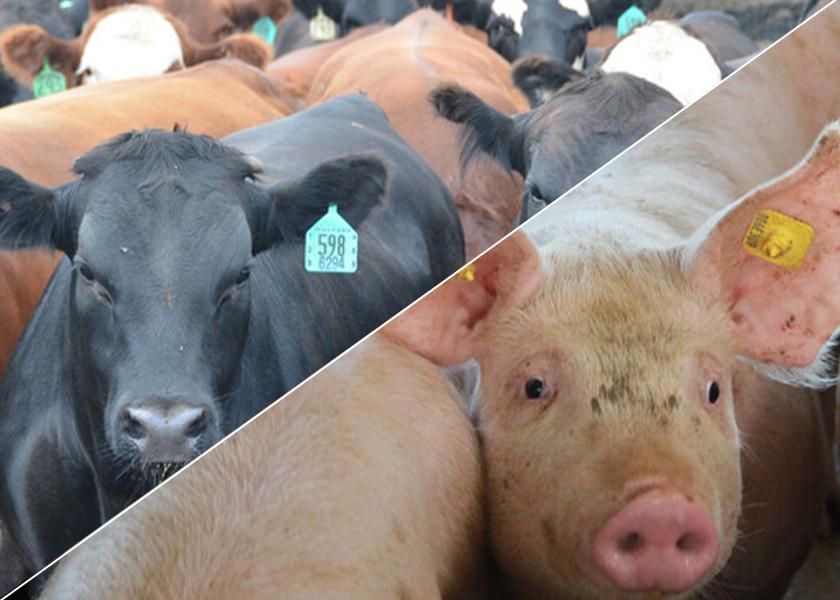Livestock Analysis | January 21, 2022

Price action: April lean hogs rose 95 cents to $94.95, up $6.50 for the week and a lifetime-high close for the most-active contract for the second straight day.
5-day outlook: This week’s slaughter total at 2.44 million head marked a 10.2% drop from year-ago levels. This continued the recent pattern of running about 10% under year-ago levels, thereby implying packers are not yet past the Covid-driven worker absences and slowdowns seen in early January. But this week’s big futures surge indicates the industry expects it will soon get back to a normal footing, with improved demand likely amplifying the usual early-winter price advance. Bulls will likely be encouraged early next week by a preliminary reading for the CME hog index at $77.51, up $1.01. Pork cutout values are also strengthening, posting a jump of $8.05 early today to $100.29, the highest since mid-October.
30-day outlook: History suggests hog prices will continue rising into mid-February. Improved pork demand, particularly for hams as the industry rebuilds ham stockpiles for Easter dinner entrees likely plays a role in the advance, as does the usual seasonal drop in hog supplies. It isn’t terribly uncommon for the rally to continue into late February. We’re reluctant to rule out such a move, especially since recent USDA data implies winter hog supplies will average a 6.0% decline from early 2021 levels.
90-day outlook: Cash hog prices often struggle to gain from mid-to-late February into early April. A portion of the general seasonal malaise likely represents diminished pork demand during Lent, particularly since hog supplies regularly continue declining toward annual lows in early summer. Conversely, grocers seemingly step up their buying in early-to-mid April as Easter and the grilling season loom ever larger. Futures imply an exaggerated advance this year thereby seeming to reflect USDA implications for a 4.0% annual reduction in spring hog supplies. April futures ended the week nearly $9.00 over February. Given the 10-year average gain of about $3.50 from mid-February to mid-April, it would be easy to assume the April future is overpriced, but we must also point out that the hog index soared about $28.50 during that period last year. We still think the summer contracts are underpriced.
What to do: Get current with feed advice. We are targeting a drop to the $385 area (50% retracement of the November-to-January rally) to further extend coverage. You remain hand-to-mouth on corn-for-feed needs. Our target for extending corn coverage would be a drop to the $5.75 area.
Hedgers: Carry all risk in the cash market for now.
Feed needs: You have all soymeal needs covered in the cash market through the end of January. You remain hand-to-mouth on corn-for-feed needs.
Price action: April live cattle fell $1.075 to $142.10, down 2.5 cents for the week. March feeder cattle fell $1.65 to $163.30, a three week low and a technically bearish weekly low close.
5-day outlook: Price direction Monday may be impacted by USDA’s Cattle on Feed Report, which was price-negative with all three categories on the bearish side of the pre-report estimates. But we doubt the data will have much lasting price impact on the market and expect focus to quickly return to wholesale price action and the cash cattle market. While cash cattle trade this week was around steady compared with last week, there was some trade at $1 lower prices than earlier in the week after the report Friday afternoon. If slaughter levels return to normal next week, cash cattle prices could trade firmer. The wholesale beef market should also support strength in the cash and futures markets next week. Choice cutout value at noon Friday dipped $0.26 to $292.72, after Thursday scoring the highest daily average since Sept. 30. Movement was light today at 46 loads.
30-day outlook: Although we’ve heard this before, health experts are now saying the latest Covid Omicron strain is peaking and will abate soon. If that’s true, beef packing plants should be back to full speed in the coming weeks, to keep the cattle marketing pipeline moving along and also likely supporting cash cattle and futures prices. Prior to the pandemic cash cattle prices had for several years shown good seasonal strength between Christmas and early spring.
90-day outlook: USDA reported net weekly U.S. beef sales at 12,800 MT for 2022, with a featured buyer including China. Today’s numbers were relatively strong and if exports in the coming weeks can remain around those levels, the cattle markets should respond favorably. Also, as springtime gets closer consumers will begin firing up their grills and throw on their favorite meat, which is beef. A couple worrisome elements for the cattle market in the coming weeks and months could be a weakening U.S. stock market and growing inflation fears. Both factors were near the front burner of the marketplace this week, which did sap trader and investor sentiment.
What to do: Get current with feed advice. We are targeting a drop to the $385 area (50% retracement of the November-to-January rally) to further extend coverage. You remain hand-to-mouth on corn-for-feed needs. Our target for extending corn coverage would be a drop to the $5.75 area.
Hedgers: Carry all risk in the cash market for now.
Feed needs: You have all soymeal needs covered in the cash market through the end of January. You remain hand-to-mouth on corn-for-feed needs.






